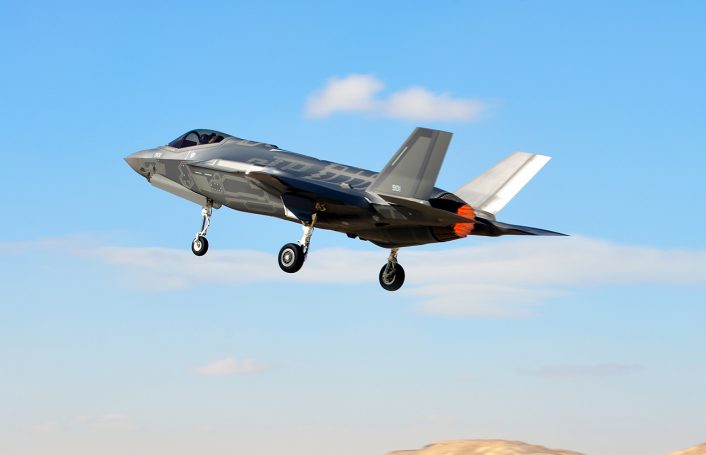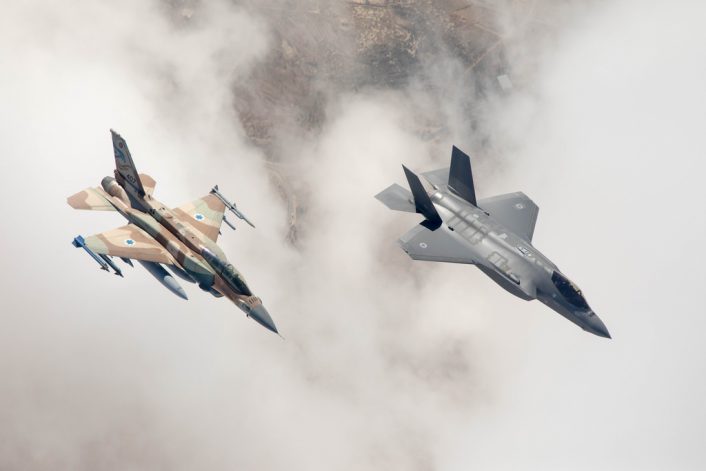Little less than a year after the first two aircraft were delivered to Israel, the Israeli Air Force F-35s have achieved IOC (Initial Operational Capability).
On Dec. 6, 2017, the Israeli Air Force has declared its first F-35 Lightning II jets, designated “Adir” (“Mighty One”) by the Israeli, operational.
“The declaration of the squadron’s operational capability is occurring at a time in which the IAF is operating on a large scale in a number of fronts, in the constantly changing Middle East”, said Maj. Gen. Amikam Norkin, Commander of the IAF in an official blog. “The operational challenge, which is becoming more and more complex each day, receives an excellent aerial response. The ‘Adir’ aircraft’s operational status adds a significant layer to the IAF’s capabilities at this time”.
The Israeli Air Force has so far received 9 aircraft that have been assigned to the 140 Sqn (“Golden Eagle”) at Nevatim airbase. The first two aircraft were delivered on Dec. 12, 2016. Five have been chosen for the assessment that has been conducted to declare the fleet IOC. As a side note, the status of the F-35 was grounded after suffering a birdstrike last month, sparking speculations that it might have been hit by the Syrian Air Defenses during a covert air strike, is unknown. Anyway, the Israeli F-35 is the first outside of the United States to be declared operational, preceded only by the U.S Marine Corps and U.S Air Force. The Italian Air Force, that has received 8 F-35s so far, has not declared IOC yet (at least officially).
“The inspection examined missions and scenarios that include all of the operational elements required to fly the ‘Adir’, from the ground to the air”, shared Lt. Col. Yotam, Commander of the 140th (“Golden Eagle”) Squadron, which operates the “Adir”. “I am confident in the division’s capability to reach operational preparedness and feel that the pressure is positive and healthy”.
What does IOC mean? Using U.S. Air Force lingo, it means that the IAF has enough operational aircraft, trained pilots, maintainers and support equipment to conduct operational missions using program of record weapons and missions systems. In simple words, it means the aricraft are capable of flying actual combat missions.
Throughout 2018, the “Golden Eagle” Squadron is expected to integrate six more fighters, while the next aircraft are scheduled to land in Israel early in the summer.
“We have yet to complete our acquaintance with the aircraft. We still have tests, development of combat doctrines and extensive learning before us”, concluded Lt. Col. Yotam in the official statement. “We haven’t stopped learning thinking and developing upon being declared operational. The establishment of the division doesn’t end with this inspection, it just begins. Will the ‘Adir’ participate in the next military campaign? I have no doubt. An aircraft like this brings capabilities to the IAF that it didn’t have before; it is an important strategic asset”.

The IAF has always been enthusiastic and vocal about the fifth generation aircraft: “As the Middle East grows more and more unstable, and as groups that threaten to destroy us race to stockpile weapons, we need to stay a step ahead of the game. The F-35 gives us the edge we need to take on groups and armies with even the most advanced technology,” said the IDF in a blog that preceded the delivery of the new aircraft.
In a farewell interview with Haaretz, Maj. Gen. Amir Eshel, former IAF Commander said: “Not everything is perfect […] There are some things you only learn on your feet. This happens with every plane that we add. But when you take off in this jet from Nevatim [IAF base], you can’t believe it. When you ascend to around 5,000 feet, the entire Middle East is yours at the cockpit. It is unbelievable what you can see. The American pilots that come to us didn’t experience that because they fly there, in Arizona, in Florida. Here they suddenly see the Middle East as a fighting zone. The threats, the various players, are in short range as well as in long range. Only then do you grasp the tremendous potential this machine has. We already see it with our own eyes.”
“This jet brings us everything we’ve dreamed of doing, in one package,” said another senior air force source, speaking on the condition of anonymity to Al-Monitor media outlet earlier this year. “It’s all concentrated on one table for us. As we all know, the F-35 can reach places in a way that others can’t. But in addition, it integrates high-level operational capabilities as well as the ability to read and analyze a battle map. The earlier, fourth-generation jets are excellent at maneuvering and activating sophisticated weapons systems, but they are not able to collect intelligence and independently analyze battle movement. The F-35 can do all this by itself in real time, with only one pilot sitting in the cockpit. We have never had such an operational capability until today. Until now, attack aircraft were operated independently of air support aircraft. The former waited to receive analysis of the battle picture that came from the latter. But in the F-35, everything is on the same platform, and this is no less than amazing. When you connect that to several aircraft, you receive strategic capability for the State of Israel.”
Indeed, what makes the F-35 one of the world’s most advanced aircraft is its high-end electronic intelligence gathering sensors combined with advanced sensor fusion capabilities to create a single integrated picture of the battlefield. However, electronic intelligence capabilities similar to those that the Israeli aircraft can put in place to get a pretty detailed view of the Middle East, can be used by neighbouring nations to spy on their fifth generation jet.
According to the same sources who talked to Al-Monitor, the heavy presence of Russian radars and ELINT platforms in Syria cause some concern: the Russians are currently able to identify takeoffs from Israeli bases in real-time and might use collected data to “characterize” the F-35’s signature at specific wavelengths as reportedly done with the U.S. F-22s.
In fact, tactical fighter-sized stealth aircraft are built to defeat radar operating at specific frequencies; usually high-frequency bands as C, X, Ku and S band where the radar accuracy is higher (in fact, the higher the frequency, the better is the accuracy of the radar system).
However, once the frequency wavelength exceeds a certain threshold and causes a resonant effect, LO aircraft become increasingly detectable. For instance, ATC radars, that operate at lower-frequency bands are theoretically able to detect a tactical fighter-sized stealth plane whose shape features parts that can cause resonance. Radars that operate at bands below 300 MHz (lower UHF, VHF and HF radars), such as the so-called Over The Horizon (OTH) radars, are believed to be particularly dangerous for stealth planes: although they are not much accurate (because lower frequency implies very large antenna and lower angle accuracy and angle resolution) they can spot stealth planes and be used to guide fighters equipped with IRST towards the direction the LO planes might be.
For these reasons, in the same way the U.S. spyplanes do with all the Russian Su-35S, Su-30SM, S-400 in Syria, it’s safe to assume Russian advanced anti-aircraft systems are “targeting” the Israeli F-35s and its valuable emissions, forcing the IAF to adapt its procedures and leverage the presence of other aircraft to “hide” the “Adir” when and where it could theoretically be detected. “This has created a situation in which the IAF is adapting itself to the F-35 instead of adapting the jet to the air force. The goal, they say at the IAF, is to use the F-35 to upgrade the fourth generation jets that will fly around the F-35,” commented Al-Monitor’s Ben Caspit.

Although it was just declared operational, it will take a few years to “completely” understand and exploit the stealth jet’s capabilities. Even more so, considered that the Israeli F-35s will have some domestic modifications and components provided by Israeli companies, that the IAF has not even begun the process of installing and integrating on the jet. Indeed, the IAF F-35As will be different from the “standard” F-35s, as they will employ national EW (Electronic Warfare) pods, weaponry, C4 systems etc.
Meanwhile the Israeli F-35s will probably see some action, validating the tactical procedures to be used by the new aircraft, fine tuning the ELINT capabilities of the “Adir” to detect, geolocate and classify enemy‘s new/upgraded systems, as well as testing the weapons system (and the various Israeli “customizations”) during real operations as part of “packages” that will likely include other special mission aircraft and EW (Electronic Warfare) support.
But only if really needed: the Israeli Air Force “legacy” aircraft have often shown their ability to operate freely in the Syrian airspace, using stand-off weaponry, without needing most of the fancy 5th generation features; therefore, it’s safe to assume the Israelis will commit their new aircraft if required by unique operational needs, as already happened in the past (in 1981, the first Israeli F-16s took part in Operation Opera, one of the most famous operations in Israeli Air Force history, one year after the first “Netz” aircraft was delivered and before all the F-16As were taken on charge by the IAF).
As we have already reported, IAF may also purchase some F-35Bs, the STOVL (Short Take Off Vertical Landing) version of the Joint Strike Fighter, that would allow the Israeli to have a squadron or two of multirole aircraft able to take off and land from austere/dispersed landing strips should Iran be able to wipe out IAF airbases with precision weapons.
So, Israel’s “journey” with the F-35 jet has just begun.









